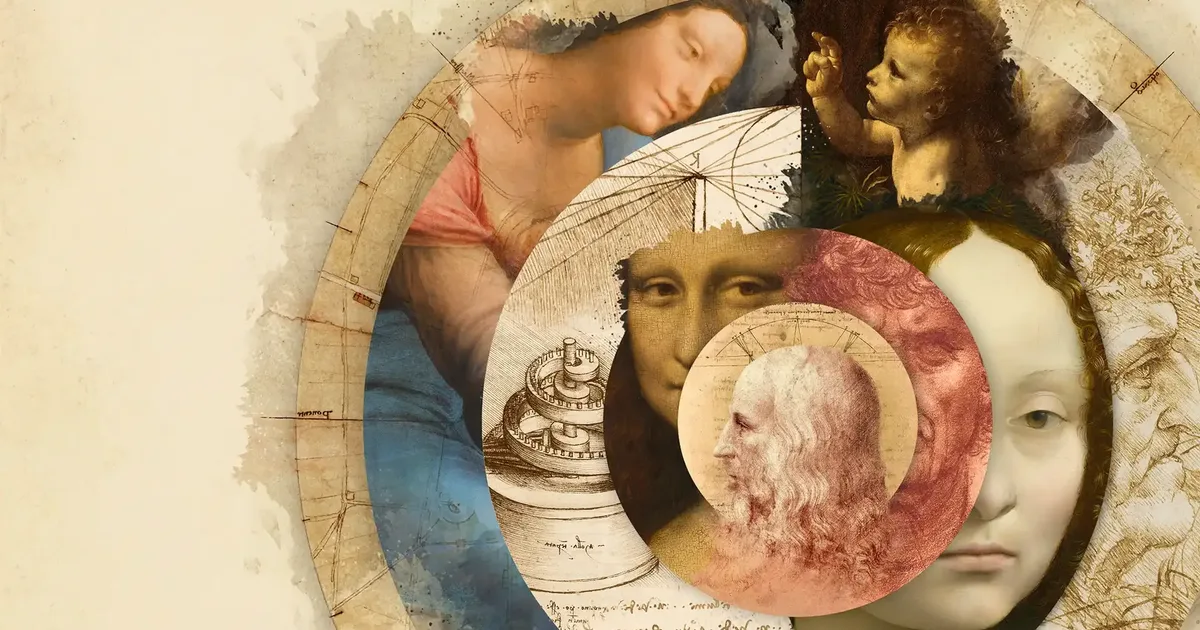
The Fascinating Life and Legacy of Leonardo da Vinci
Leonardo da Vinci, a name synonymous with genius, remains one of history’s most captivating figures. Born out of wedlock on April 15, 1452, in Vinci, Italy, Leonardo di ser Piero da Vinci transcended the limitations of his era, leaving an indelible mark on art, science, and engineering. His insatiable curiosity, coupled with unparalleled talent, propelled him to heights of achievement rarely equaled, shaping the course of Western civilization in profound and lasting ways. This exploration delves deep into his extraordinary life, examining his artistic masterpieces, groundbreaking inventions, anatomical studies, and the enduring legacy that continues to inspire awe and wonder centuries later.
I. Early Life and the Seeds of Genius:
Leonardo’s early life in the Tuscan countryside fostered a deep connection with nature. The rolling hills, vibrant flora, and diverse fauna of Vinci provided a rich tapestry of inspiration that fueled his insatiable curiosity. Unlike many children of his time, Leonardo received a somewhat unconventional education. While basic literacy and arithmetic were part of his foundation, his natural inclination towards observation and experimentation took precedence. His father, Piero da Vinci, a notary, recognized his son’s exceptional abilities and, at the pivotal age of 14, apprenticed him to Andrea del Verrocchio, one of Florence’s leading artists.
Verrocchio’s workshop served as a crucible for Leonardo’s burgeoning talents. Surrounded by skilled artisans, sculptors, and painters, he honed his artistic skills, mastering techniques in painting, sculpture, and metalworking. The workshop’s emphasis on observation and realism profoundly influenced Leonardo’s approach to art, laying the groundwork for his unique and revolutionary style. This period wasn’t merely about technical proficiency; it also nurtured his intellectual curiosity. He absorbed knowledge from various disciplines, including mathematics, geometry, and anatomy, demonstrating an early aptitude for interdisciplinary thinking—a hallmark of his later achievements. The collaborative environment of the workshop exposed him to a breadth of knowledge and fostered an ethos of inquiry that would become central to his life’s work. The seeds of genius were sown, and the ground was fertile.
II. The Artistic Revolution: Masterpieces and Techniques:
Leonardo da Vinci’s artistic career was a continuous exploration of form, light, and human emotion. He didn’t merely paint; he meticulously studied and understood the subjects he portrayed. His artistic genius is most profoundly reflected in his masterpieces, works that continue to captivate and inspire audiences across centuries.
The Mona Lisa: This enigmatic portrait, housed in the Louvre Museum, transcends its status as a mere painting. Lisa Gherardini’s subtle smile and the almost ethereal quality of the painting have captivated viewers for centuries, sparking countless interpretations and inspiring artists and writers alike. Da Vinci’s mastery of sfumato, a technique that uses subtle gradations of light and shadow to create a soft, hazy effect, is strikingly evident. This technique, which lends the painting its dreamlike quality, was a significant innovation in Renaissance painting, demonstrating a profound understanding of light and its effects on human perception. The psychological depth of the portrait, the almost imperceptible hint of a smile that seems to shift with the viewer’s gaze, is a testament to Da Vinci’s ability to capture the intangible essence of his subject.
The Last Supper: This iconic fresco, located in the Santa Maria delle Grazie refectory in Milan, depicts the dramatic moment when Jesus reveals that one of his disciples will betray him. The masterful use of perspective, composition, and emotional expression is breathtaking. Da Vinci’s innovative use of linear perspective creates a powerful sense of depth and drama, drawing the viewer’s eye towards the central figure of Christ. The emotional turmoil of the apostles, individually rendered with remarkable psychological insight, adds another layer of complexity to the narrative. The composition’s powerful geometry, the careful arrangement of figures around Christ, is a testament to Da Vinci’s understanding of both artistic principles and human psychology. The enduring power of this masterpiece lies in its ability to evoke intense emotional responses, sparking contemplation about faith, betrayal, and the human condition.
Vitruvian Man: This iconic drawing, a study of human proportions, encapsulates Da Vinci’s fascination with both art and science. Based on the writings of the Roman architect Vitruvius, the drawing depicts a nude male figure superimposed within a circle and a square, illustrating the ideal proportions of the human body as described in classical texts. The Vitruvian Man is a remarkable synthesis of artistic skill and scientific inquiry, demonstrating Da Vinci’s dedication to understanding the underlying principles governing the natural world. Its enduring appeal stems from its elegant simplicity and its enduring relevance as a symbol of the harmonious relationship between human form and the cosmos.
Beyond these iconic works, Leonardo’s artistic output encompasses a vast array of drawings, sketches, and paintings, demonstrating an incredible versatility and an unrelenting commitment to his art. His studies of human anatomy, landscapes, and mechanical devices are invaluable not only for their artistic merit but also for their scientific accuracy and insight.
III. Engineering and Scientific Innovations: A Visionary Ahead of His Time:
Leonardo da Vinci wasn’t merely an artist; he was a prolific inventor and engineer whose designs and ideas often predated their technological realization by centuries. His notebooks, filled with thousands of drawings, sketches, and notes, reveal a mind teeming with inventive concepts. These weren’t mere flights of fancy; many of his designs incorporated practical engineering principles that demonstrated a remarkable understanding of mechanics, physics, and mathematics.
Flying Machines: Leonardo’s designs for flying machines, including the ornithopter (a machine designed to mimic the flight of birds), are considered precursors to modern aviation. Though not built during his lifetime, his designs demonstrate a profound understanding of aerodynamics and the principles of flight. These designs, meticulously detailed in his notebooks, reveal an exceptional grasp of engineering principles, including lift, thrust, and control surfaces. The ornithopter, with its flapping wings driven by a complex system of levers and gears, represents a remarkable testament to Leonardo’s visionary thinking and his ability to translate theoretical concepts into practical designs.
Military Engineering: Da Vinci’s designs for military technology, including armored vehicles, crossbows, and other weapons, reflect a profound understanding of mechanics and military strategy. His innovative designs weren’t simply about destruction; they often incorporated elements of defensive engineering, showcasing his commitment to both offensive and defensive capabilities. These designs, some of which are astonishingly prescient, reflect Leonardo’s ability to adapt his knowledge of mechanics and materials to solve practical problems of war and defense. His designs reflect not just a mastery of engineering but also a deeper understanding of the dynamics of warfare.
Civil Engineering: Leonardo’s contributions extend to civil engineering, with his innovative designs for bridges, canals, and urban planning. He envisioned solutions to improve urban environments, create more efficient transportation systems, and address practical challenges of construction and infrastructure development. His designs often incorporated advanced principles of structural engineering and materials science, showing a clear understanding of load distribution, stability, and construction techniques.
Leonardo’s scientific inquiries extended beyond engineering, encompassing fields such as anatomy, botany, geology, and optics. His meticulous observations and detailed drawings of plants, animals, and the human body are stunning examples of his scientific rigor and his ability to combine artistic skill with scientific observation. His notebooks serve as a repository of his scientific explorations, reflecting a mind that constantly sought to understand the complexities of the natural world.
IV. Anatomical Studies: A Pioneer of Medical Science:
Leonardo da Vinci’s anatomical studies represent a significant contribution to the advancement of medical science. Through dissection and detailed observation, he produced accurate and remarkably detailed anatomical drawings. These drawings, often surpassing the anatomical knowledge of his time, were not merely artistic representations; they were scientific documents, revealing a comprehensive understanding of human physiology.
Da Vinci’s anatomical work involved dissecting human corpses, a practice considered unconventional during his era. His diligent study of the human body provided him with an in-depth understanding of the skeletal structure, musculature, and organ systems. These studies significantly impacted his artistic representations of the human form, enriching the realism and anatomical accuracy of his paintings and sculptures. His meticulous drawings of the human heart, brain, and other organs reflect a deep understanding of their structures and functions, surpassing the existing knowledge of the time.
His anatomical sketches are also noteworthy for their artistic merit. He skillfully captured not only the anatomical details but also the overall form and grace of the human body, demonstrating his ability to blend scientific accuracy with artistic expression. His anatomical studies represent a remarkable achievement, combining artistic talent with scientific rigor to create a lasting contribution to the field of medicine.
V. Legacy and Enduring Influence:
Leonardo da Vinci’s legacy extends far beyond his individual accomplishments. His boundless curiosity, his relentless pursuit of knowledge, and his unwavering commitment to innovation have inspired generations of artists, scientists, engineers, and thinkers. His work continues to resonate with contemporary audiences, influencing artists, designers, and innovators in diverse fields.
Artistic Influence: Da Vinci’s influence on painting and art is undeniable. His innovative techniques, his masterful use of light and shadow, and his profound understanding of human anatomy continue to inspire artists today. His artistic legacy is not only in the specific works he created, but also in the techniques and approaches he pioneered, influencing generations of artists.
Scientific Impact: His scientific contributions, though often ahead of their time, laid the groundwork for numerous advancements in engineering, mechanics, and other scientific disciplines. His work on aerodynamics, mechanics, and human anatomy provided valuable insights that continue to inspire contemporary scientific research.
Cultural Significance: Da Vinci’s image has become a symbol of universal genius, creativity, and innovation. He continues to inspire creative minds across multiple disciplines, from art and science to engineering and technology. His life and work have been the subject of countless books, films, and documentaries, shaping how we perceive genius and innovation. His notebooks, filled with cryptic notes and sketches, serve as a constant source of fascination, sparking new interpretations and insights.
In conclusion, Leonardo da Vinci’s life and work represent a unique and unparalleled fusion of artistic talent, scientific inquiry, and engineering innovation. His legacy extends far beyond the individual masterpieces he created. He embodies the spirit of the Renaissance, a period of immense intellectual and cultural flourishing. His enduring influence serves as a testament to the boundless potential of human creativity and the transformative power of an inquisitive mind. The world continues to learn from Leonardo da Vinci, his insatiable curiosity and pioneering spirit remaining a beacon of inspiration for generations to come. His life and work stand as a powerful reminder of the enduring power of creativity, the importance of interdisciplinary thinking, and the boundless possibilities that arise when art and science intertwine.


